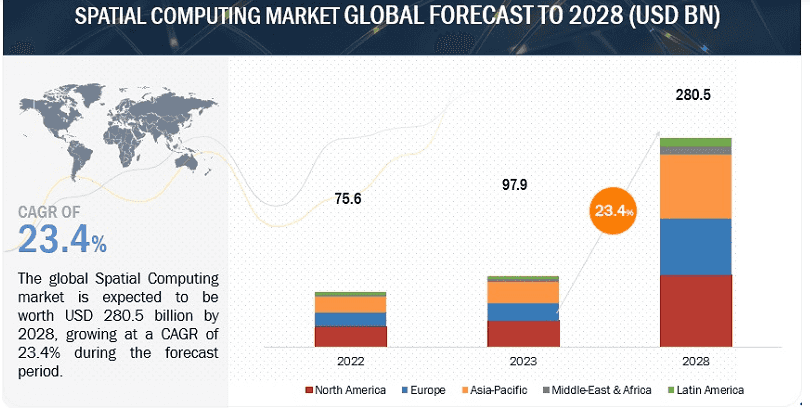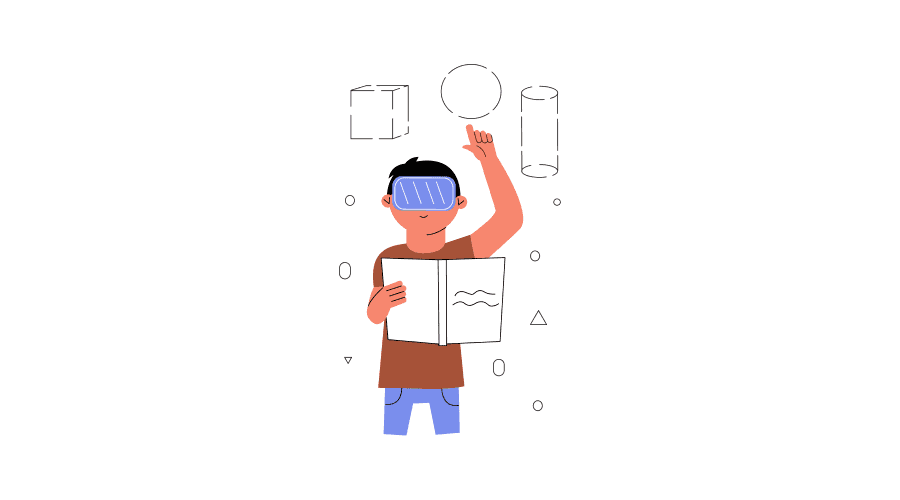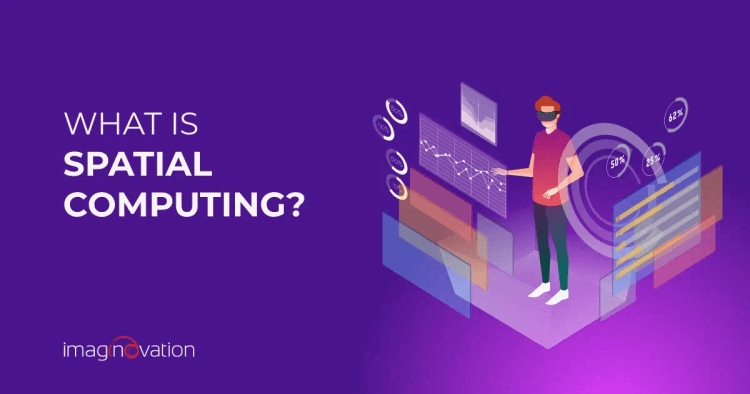Spatial computing is not just a futuristic concept anymore. It’s a cutting-edge technology that is quickly transforming how businesses communicate, operate, and engage their audience.
And with its market size expected to reach $280.5 billion within four years, business leaders should consider adopting this technology into their enterprises as soon as possible.
Have you considered using spatial computing technology but don’t know how? This guide will help. It explains the ins and outs of spatial computing, highlighting the key technologies behind it and potential applications.
Understanding Spatial Computing
The phrase “spatial computing” is attributed to Simon Greenwold, a researcher who first mentioned it in his 2003 paper. GreenWold defined it as technology that allows humans to interact with machines, whereby the machine maintains references to physical objects and spaces.
A simpler way of defining spatial computing is that it’s a blend of innovations and technologies that merge the digital and physical worlds.
By deploying a spatial computer - typically in the form of goggles - users can view the real world around them and other components overlayed on top of this real-world setting. They can even interact with this digital realm using their bodies, usually their hands.
Development of Spatial Computing Technologies
Since its invention in the 2000s, spatial computing has undergone significant development. With each passing day, more individuals and companies are adopting this technology and using it for various applications.
One of the most notable inventions in recent times is the Vision Pro by Apple. Relying on VisionOS - the first-ever spatial computing operating system- these glasses use highly advanced sensors that respond to the user’s eyes and hands. This makes interaction with digital content possible by simply using natural gestures.
With such advancements, it is no wonder spatial computing is quickly gaining traction in the digital space and other sectors. For instance, it has completely transformed how companies train their workers.
Instead of the traditional classroom-based training technique, workers can now enjoy interactive learning experiences.
They can interact with objects as though they were in the real world. They can also manipulate these objects and practice real-life scenarios without worrying about making mistakes. This learning approach also helps individuals overcome geographical barriers as they can access digital content wherever they are.
The high adoption rate is one of the factors driving the spatial computing market. Here’s a chart showing its current and forecasted growth rate.

The graph shows that the spatial computing market was valued at $75.6 billion in 2022. In a span of just one year, it increased to $97.9 billion. If it continues growing at this pace, it will reach $280.5 billion by 2028.
Key Technologies Behind Spatial Computing
The beauty of spatial computing lies in how it all comes together. Oftentimes, spatial computing applications follow a four-stage process that involves:
- Detecting and capturing real-world data
- Processing captured data in real time
- Creating a digital version of the physical world
- Displaying content in a simulated environment that allows for interactivity
Executing each step requires special cameras, sensors, and sophisticated algorithms that rely on artificial intelligence and machine learning. Highlighted below are some of the technologies that make spatial computing possible.
Computer Vision
An integral element of machine learning, computer vision is the concept behind grand inventions like self-driving cars. This technology is designed to capture and decode visual data using advanced cameras.
This process enables computers to view and understand the immediate environment in the same way that the human brain perceives it.
Sensor and Sensor Fusion Technology
Sensor technology is equally vital to spatial computing. Its role is to continually gather data from the physical environment.
Relying on devices like cameras, GPS, and LiDAR, this technology monitors the position and movement of objects in real time. Sensor fusion is the ability to blend this data from multiple sources, be it cameras or GPS.
Machine Learning
Another intelligent technology that makes spatial computing possible is machine learning. This intelligent system is used to process raw data and, hence, gain a deeper understanding of the spatial organization.
Deploying machine learning tech has several benefits, including increased sensor accuracy, predictive analysis, and pattern detection.
Spatial Mapping
As the title implies, this technology generates a 3D map of your surroundings using data captured by cameras, sensors, and other hardware. The idea is to make the digital world appear as realistic and visually appealing as possible.
Edge Computing
Edge computing technology facilitates immediate data processing. Without it, the data would have to be transmitted to a data processing center, causing delays.
Internet of Things (IoT)
IoT makes it possible for interconnected devices to communicate using sensors. This enables the spatial computing system to better understand the user’s current surroundings.
Digital Twin
This technology enables spatial hardware to generate a replica of the physical world in the digital realm. Using data captured by sensors or cameras, it maps point clouds and creates a virtual copy of the real setting.
Applications of Spatial Computing
Let's dive into the key applications of spatial computing across different industries.
Manufacturing
One industry that has reaped immense benefits from spatial computing is manufacturing. The technology has been used to design smart factories where machines interact more intuitively with their surroundings.
We now have specially designed robots capable of navigating spaces independently. These machines can spot obstacles and map routes in real-time, optimizing efficiency.
Spatial computing technology is also being deployed in product design. Engineers and designers leverage AR and VR environments to envision 3D models of products in the physical world. Thanks to this, they can make quick iterations and adjustments, saving time.
Using this technology in product design also enables engineers to spot defects in time. This way, they can fix flaws in the early development stage.
Healthcare
Spatial computing is also being used to improve different healthcare sectors. One such application is in medical training.
AR and VR technologies have enabled medical students to practice medical techniques in virtual settings. This has allowed them to better understand human anatomy and surgical procedures without practicing with actual patients.
Spatial computing is also being used to improve patient care. Surgeons can now use AR headsets to identify the precise locations of internal organs and structures. This increased precision enhances the likelihood of getting a positive outcome.
Education

This technology has also proven beneficial in education, where it’s gradually replacing textbooks and traditional media. Students have an opportunity to immerse themselves in 3D settings that bring complex concepts to life.
For instance, science students can examine complicated molecular structures in an interactive 3D environment. Similarly, history students can take a virtual trip to ancient civilizations and relive past events. Such interactivity helps learners understand concepts better while also boosting their engagement.
Gaming and Entertainment
Gaming and entertainment were among the first sectors to apply spatial computing. The technology allows gamers to interact with characters and objects in virtual settings. Instead of controlling characters from a keyboard or joystick, you can use your gaze or hand gestures to mimic similar movements.
On the entertainment front, spatial computing allows individuals to experience events more intuitively. With the help of the Apple Vision Pro headset, you can watch blockbuster movies as if you’re sitting in the front-row seat of a cinema.
Data Analytics
Analyzing corporate data is time-consuming and daunting for those lacking ample experience. Thankfully, this is one of the areas where spatial computing can be put to use. By envisioning data in 3D virtual or augmented settings, data analysts can easily draw relationships and patterns between variables.
For instance, AR allows for the overlapping and anchoring data points to physical objects. This, in turn, offers new insight regarding the simulation outcomes and sensor readings.
SeeSignal is an excellent example of a spatial computing application in data analytics. The app, invented by BadVR, uses immersive technology to help users visualize their network data. It allows you to view network readings in real time, spots dead zones, and does so much more.
Big enterprises like NASA are also deploying this technology for their data analytics. According to this article published last year, the firm employs VR and AR to analyze Mars Rovers data.
Retail
Retail is another sector reaping massive benefits from spatial computing. Consumer brands use this technology to offer personalized shopping experiences via virtual try-ons and product visualizations.
For instance, Warby Parker allows you to virtually try on up to different frames before purchasing. Similarly, IKEA helps you envision how furniture pieces look in your space before buying.
Such technologies enable customers to be more confident in their purchase decisions. This minimizes the risk of returns and boosts retailers’ sales.
Remote Aid and Collaboration
Although rare, spatial computing is also used to improve remote aid and collaboration.
More specifically, experts and technicians are using this technology to guide field workers in real-time. By using devices like Microsoft’s HoloLens, they can overlay digital content on the user’s view, hence assisting them remotely.
This doesn’t just benefit companies with teams that work remotely. Businesses in any niche can leverage this technology to offer guidance to distant customers in real time. This not only boosts efficiency but also eliminates travel costs and downtime.
The Future of Interactivity with Spatial Computing
Despite its remarkable benefits in improving interactivity, spatial computing has experienced mixed reception. Some corporate giants - like Microsoft and IKEA - have embraced the technology with open arms. However, others are a bit hesitant to get on board, and understandably so.
One of the greatest hurdles facing the implementation of spatial computing is the steep hardware pricing. For instance, Apple’s Vision Pro glasses cost at least $3,500. In addition to being pricey, they’re not readily available.
This is why spatial computing has yet to make a breakthrough in the consumer space. Many businesses fear that the high costs outweigh the potential benefits.
But, as spatial computing technology progresses, the cost of related hardware will begin to decrease. The more this sector evolves, the more competitive and affordable it will be. This will allow both large and small/medium-sized businesses to adopt it.
Cost aside, the future of spatial computing also depends on other aspects, like user-focused innovation. Customization and user-centric content creation will be prime factors for attracting and retaining clients in this sector.
Generally, the future of spatial computing looks promising. With advancements in AI, haptic feedback, and refined hardware, we’re likely to see a more seamless and interactive virtual environment.
Develop Apps Based on Spatial Computing with Imaginovation
As spatial computing technology progresses, businesses can discover new avenues for growth and success. By leveraging immersive interactions, they can automate various processes and provide more personalized shopping experiences.
But given the steep investment, you’ll want to ensure you get it right the first time. And that’s where we come in. Our award winning team at Imaginovation will work with you to develop spatial computing apps tailored just for your business.
Get in touch, and let us guide you on this transformative journey!




